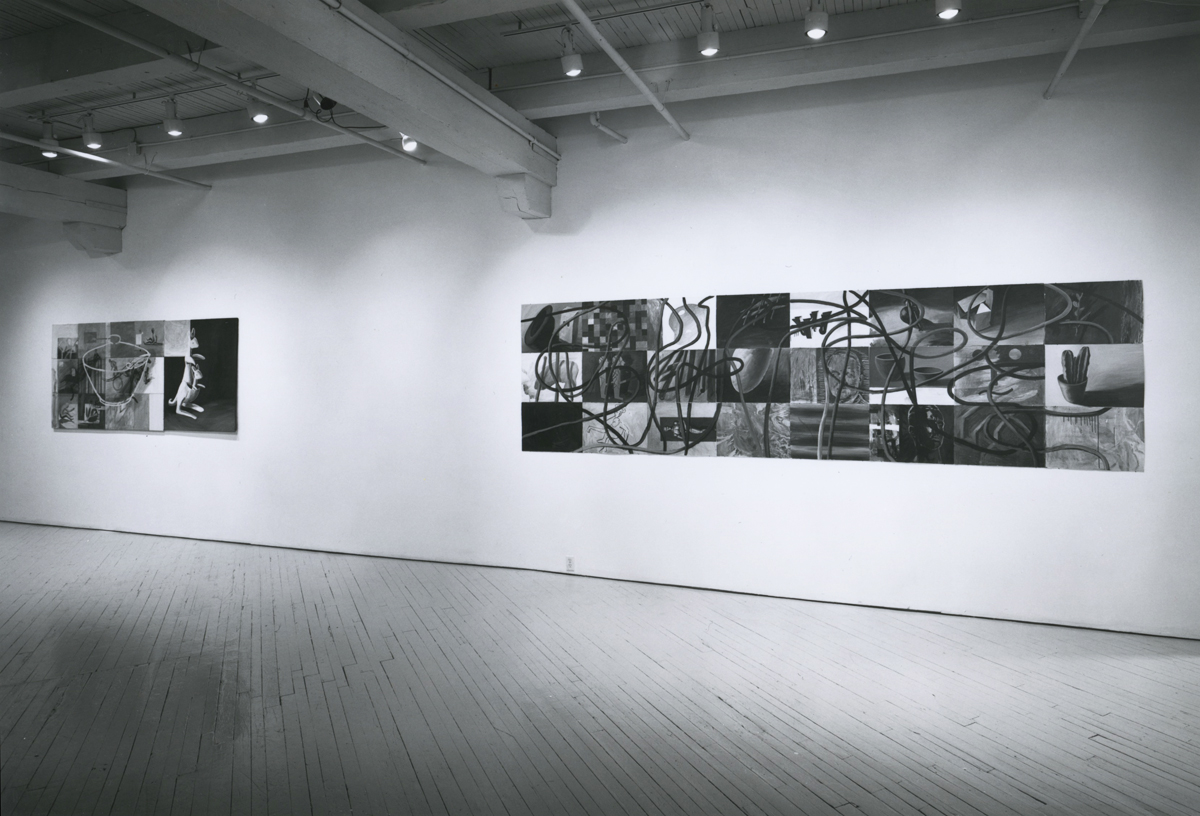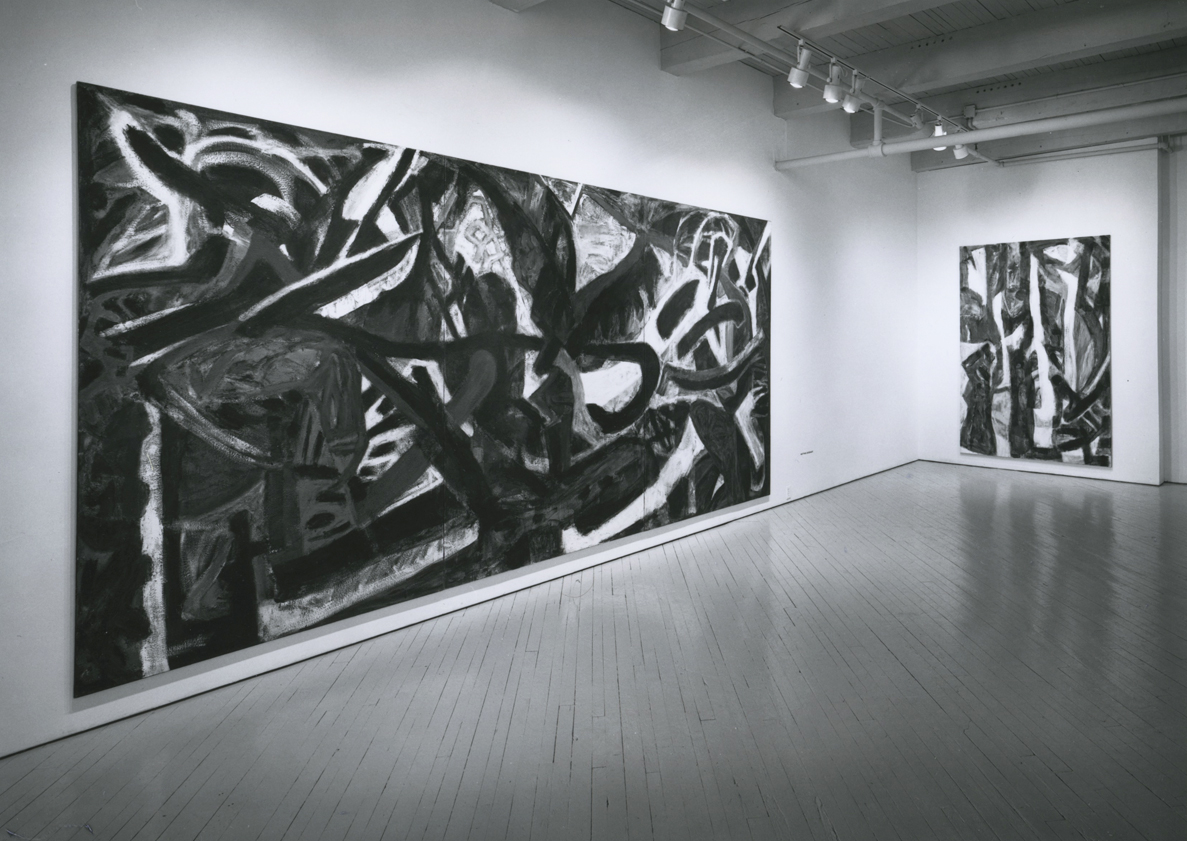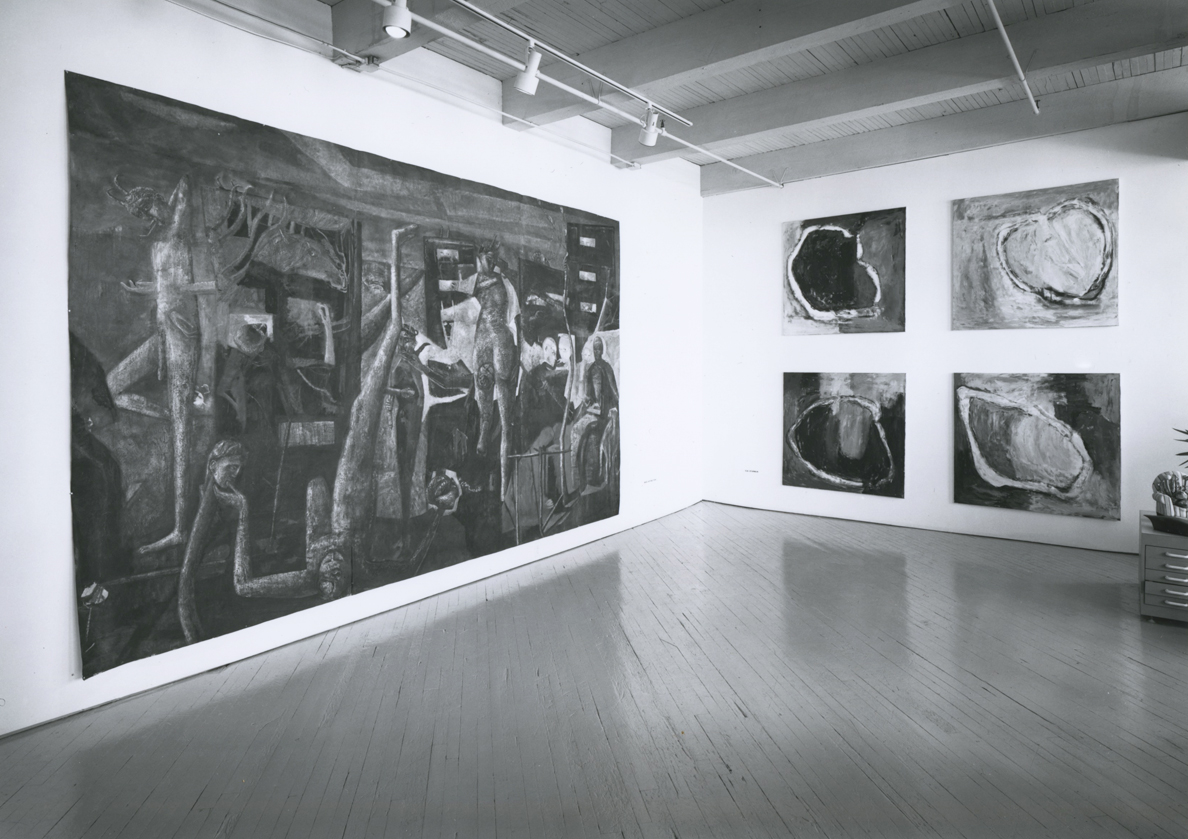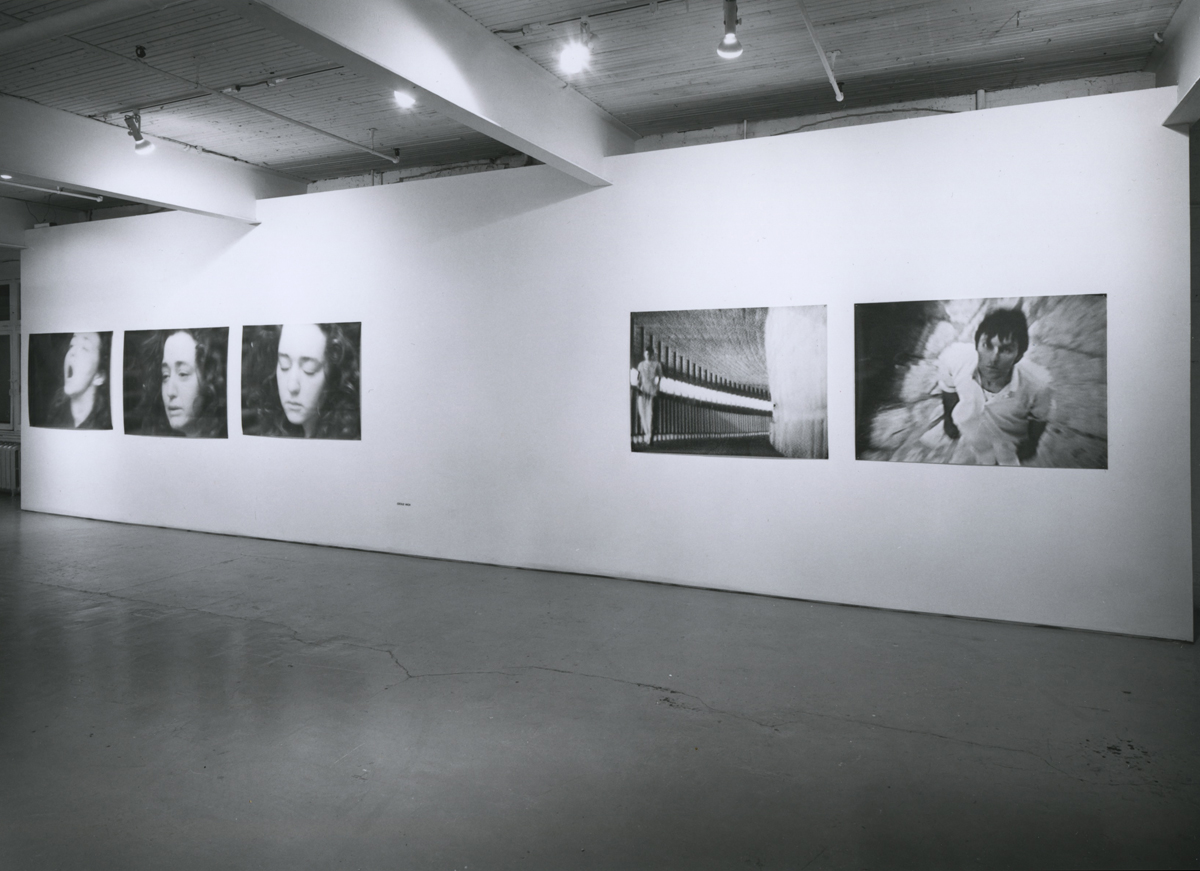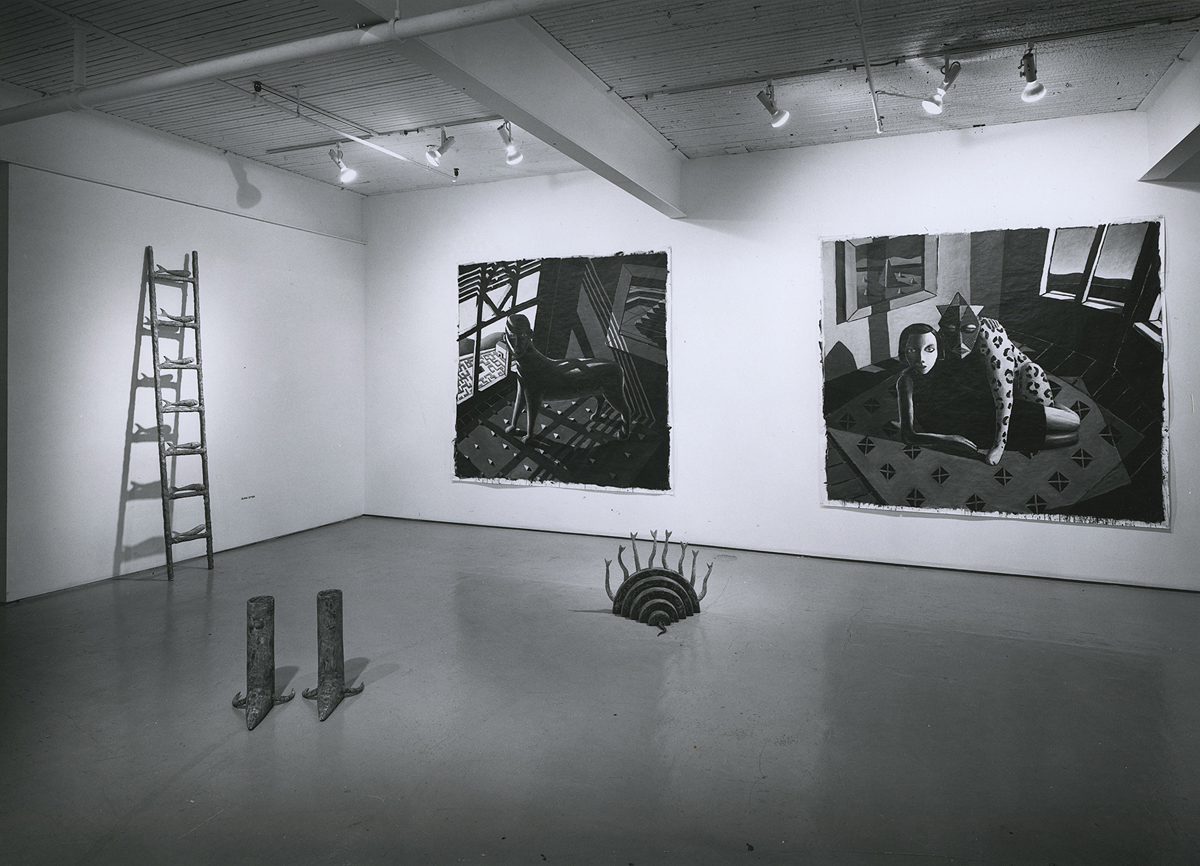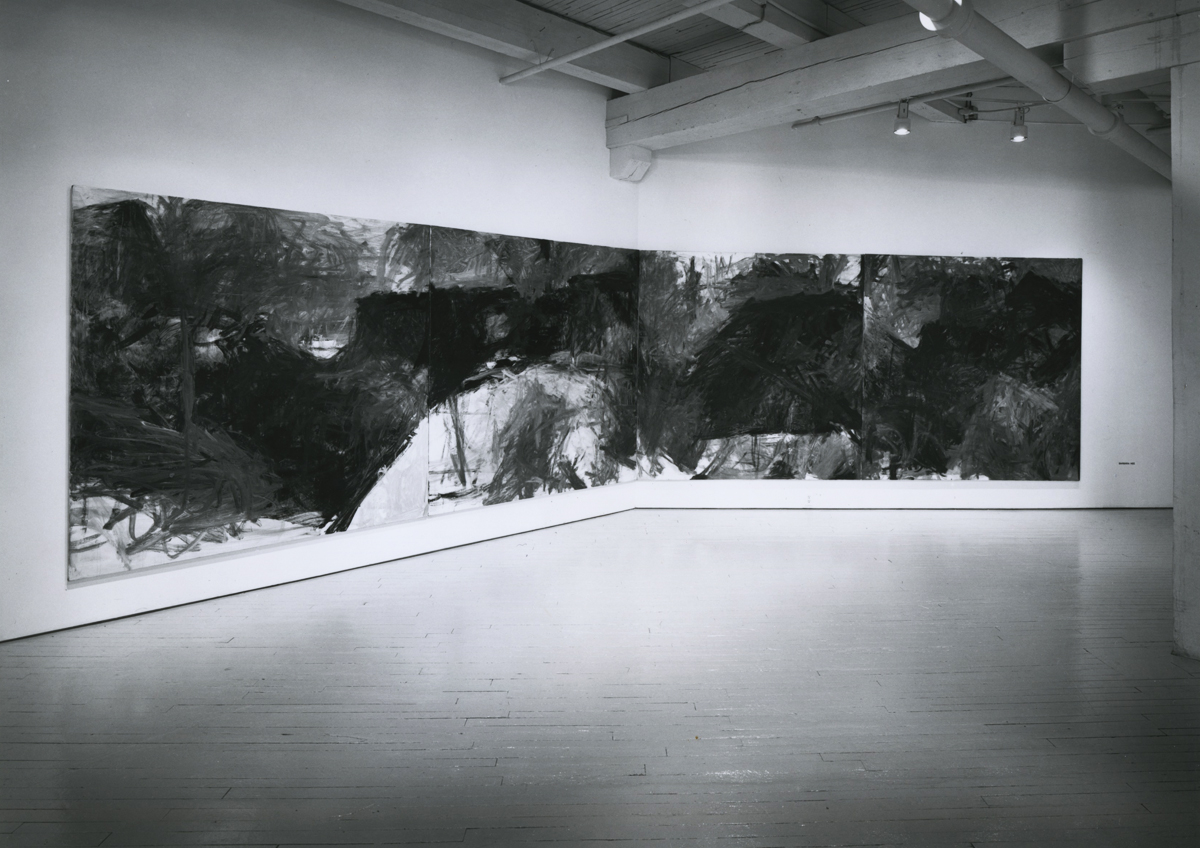Spectrum Zurich, a group exhibition featuring work by twelve emerging Swiss artists, will open at Mercer Union and Grunwald Gallery on Saturday August 16 from I pm to 5 pm and will continue through September 6, 1986.
The twelve participating artists represent a diverse cross-section of the contemporary art scene in Zurich. The works in this exhibition encompass a broad range of styles, including abstract expressionism, surrealism, photographic realism and narrative figuration. Working primarily in painting, sculpture and photography, the artists address a variety of concerns in their work including issues regarding our decaying industrial society and contemporary social structures. Although not currently a part of the international mainstream, the artists, ranging in age from 28 to 36, have each participated in at least one solo exhibition at a recognized museum or gallery and have received at least one major arts award. Six artists will be featured in each gallery space. On view at Mercer Union will be works by Luigi Archetti, Matthias Bosshart, Marc-Antoine Fehr, Andreas Hofer, Carlos Matter and Uwe Wittwer. Works by Lucia Coray, Olivia Etter, Barbara Hée, Dieter Leuenberger, Eva Sturmlin and Cecile Wick will be on view at Grunwald Gallery, 80 Spadina Avenue, 4th floor.
The curators of the exhibition are Elisabeth Grossman, Henry F. Levy, Martin Pauli and Hanspeter Marti. Elisabeth Grossman is an art historian, and director and curator of the cantonal art museum of Thurgau (Kartause Ittigen).
Henry F. Levy, founder and organizer of the BINZ39 Gallery in Zurich, participates in the selection of German artists for P.S. 1 in New York, and has set up his own exchange with P.S. 1 for Switzerland. Martin Pauli is the director of the Galerie Walcheturm which was created to provide promising artists with exhibition space. A Canadian citizen residing in Zurich, Hanspeter Marti is a practising artist/photographer and former member of Chromazone.
Spectrum-Zurich comprises the Swiss counterpart of a dynamic art exchange between Toronto and Zurich. Fire + Ice, an exhibition held last November at Galerie Walcheturm and BINZ39, featured the work of fifteen Toronto artists. The intention of the curators is to engage both Swiss and Canadian artists and viewers in an international dialogue.
Spectrum Zurich will be accompanied by a catalogue which is being produced in Switzerland. Eleven of the twelve participating artists and the exhibition curators will be present for the opening of this exhibition.
Support for this exhibition has been provided by the Consulate General of Switzerland, the Swiss Council for the Arts PRO HELVETIA and the Swiss Canadian Cultural Association.
REVIEW
Spectrum Zurich
Mercer Union and Grunwald Gallery
August 16 to September 6
Jerry McGrath
Vanguard, October/November 1986
Spectrum Zurich is the reciprocal installment of an exhibition exchange between that city and Toronto. (Last November, Fire + Ice, representing is artists from Toronto, opened at Galerie Walcheturm and BINZ39.) By all appearances, Zurich is also an ecumenical place. The catalogue, rather than explicating the common environment from which so much disparate expression arises, provides short biographies and bilingual entries vague enough to be applied to a second or third dozen of this generation and milieu. The English versions, 'translated and interpreted' by Henry F. Levy, one of the four curators, are unfortunate in their feeble command of the language. The viewer is better off steering clear of them altogether and letting the artists be their own ambassadors.
Within this small survey are several approaches linked to recognizable styles: Surrealism, abstraction, hyper-realism, primitivism and more. In most instances, the works de-emphasize 'making it new' and establish themselves as late, less urgent forays into received pictorial strategies. The few pleasures offered involve the viewer in inherited forms without reanimating their once attendant polemics.
Marc-Antoine Fehr's epic stretch of medieval gloom has, as one of many freely-distorted figures, a horned variant on a deposition. Red limbs glow like blacksmith's tools and yellow window slits give inhabited towers the aspect of furnaces or crematoriums. In two works by Andreas Hofer this suffocating accretion gives way to high, remote interiors with hybrid creatures sharing anatomies of man and beast. Arabesques of shadow and decorative geometry suggest severe formal codes that accentuate the captive, insular circumstances of the soulful inhabitants. Hofer and Fehr invoke Christian and pagan mythologies that - via the stress they place upon feeling and intellect - are distinct in being respectively hot and cool.
Abstraction, broadly speaking, situates Matthias Bosshart, Barbara Hee, Eva Sturmlin, and Uwe Wittwer. The first, though linked by the catalogue to action painting, uses stubborn dry pigment and is less mercurial than might be expected. Nevertheless, Bosshan's two works, with their limited palette of browns, greens, and whites, are satisfying in their chromatic allusion to nature and in the solid structuring and gravity of their elements.
Barbara Hee's four-panelled mural extends its athletic facture into landscape dimensions. Moving from left to right, the viewer notes how the topographical is finally smothered in painterly foreground on its way to becoming surface. Turner, Guston and Twombly figure in this familiar recapitulation . Eva Sturmlin's four variants on a ring-like structure reminiscent of bone seem involved with refining a statement about the act of painting itself. In these serial productions, her constant motif becomes brittle, like a tea-cup handle that cannot survive too rude a grip. Her project is so inured to nuance, so keen to shade the sensorium, that by comparison trimming one's nails might be considered as weight loss.
Uwe Wittwer's abstracts are similarly precious in their dependence on the studied economy of charging the space between pairs of lightly-sketched poles on a dark ground. Seldom has so little paint been expected to do so much. More eccentric works distinguish Carlos Matter and Olivia Etter. The former is represented by convex wall pieces, which also use graphic pictorial means to suggest tensile supports and extensions - an engineer's sens ibility looking for poetic equivalents. The only sculptures in the show, Etter's works include a ladder, each rung of which supports a finely scaled cast fish of exquisite manufac ture. A second piece consists of a pair of red boots with horn-like spurs, devilish 'winkle-pickers' extrapolated, perhaps, from the work of Fehr.
Dieter Leuenberger's hyperrealistic reportage on steel process, from blast furnace to retort to high-polished product, is captive to its own effects and would sit well on the walls of a corporate office. A similarly incidental pleasure quickly evaporates from the surfaces of Lucia Coray's pictures. Their elastic cartoonish figures are schemata tinctured with sentiment and nostalgia, especially for Matisse and Picasso.
Perhaps the most interesting of these artists is Luigi Archetti. His modular wall-pieces are structured like visual calendars: they uphold a democratic strategy of assigning standardized dimensions of the overall surface to elements from a broad image-repertoire. This specificity is diaristic in that each element seems only a momentary preoccupation. Their syntax borrows the disjunctiveness of a wall of TV screens in the recreational appliance section of a department store. There are episodes of figuration, abstract passages, portrait heads, hats, cups, potted plants, and leaping kangaroos. In one work, fat meandering lines cross over some images and illusionistically snake behind others. Separate images are further subdivided, linked, and obscured. Stylistically, Archetti seems to accommodate most of his colleagues. Like the kangaroo, his apparent totem, we are expected to jump around inside his perimeters and enliven the inventory with our locomotion.

